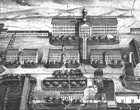The consequences of slavery for white people defined the fundamental tension between the North and the South. That conflict was not, contrary to long-held belief, a clash between an industrial North and a backward and isolated South. More than half of white northerners, after all, lived and worked on farms and exceedingly few worked in factories; most were skilled or common laborers in smaller towns and cities. The South, for its part, was the fourth richest economy in the world and seemed destined to play an ever-greater role in fueling the growth of England and France as well as the North. The slave property of the South was worth three times all the railroads and factories of the North, combined, in 1860. Slave prices had never been higher and the price and demand for cotton had never been stronger. Cotton, in fact, had steadily become more crucial to the United States economy; by 1860, the staple accounted for more than 60 percent of all American exports and showed every sign of increasing its domination.
The South underwent a particular kind of economic growth, quite unlike that in the North, for plantations accounted for much of the economic energy in the South and the South rapidly replicated its profitable plantation model over an enormous area. In the process, slave states did not generate the population density that sustained towns and economic development in the free states, and to the eyes of northern visitors the slave South looked underpopulated and underdeveloped. The slave South developed less manufacturing than the North because agriculture was so profitable in the South, because available capital went into purchasing more enslaved people and more land, and because no structural or seasonal surplus of wage labor was available for factories. Yet slavery proved adaptable to urban manufacturing when the conditions were right; cities in the upper South, such as Richmond and Petersburg, saw enslaved people increasingly at work in tobacco and iron factories. States in the South spent aggressively on economic development, on railroads in particular, and did not imagine themselves as somehow apart from the commercial world that gave slavery its reason for being.
Slaveholding, while extremely profitable, was virtually the only way to become truly prosperous in the South. That very profitability proved a challenge for the South, because as the price of slaves increased, the percentage of white families who owned slaves decreased. In 1840, about a third of white families owned at least one slave; by 1860, about a fourth did. White people in the South who did not own slaves were deeply implicated in the system, with large numbers of non-slaveholders hiring enslaved workers, trading with plantation owners, acting as bankers or insurers, and aiding the slave trade. Non-slaveholders could sustain quite respectable family farms, gain respect as ministers or lawyers, or run shops in towns, but they could not attain the heights of their slaveholding neighbors.




